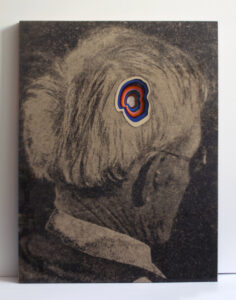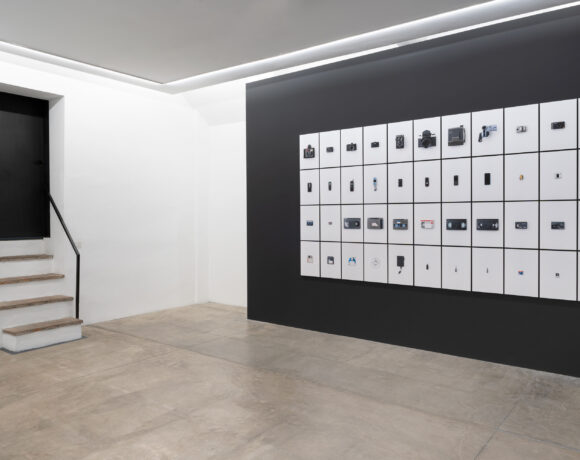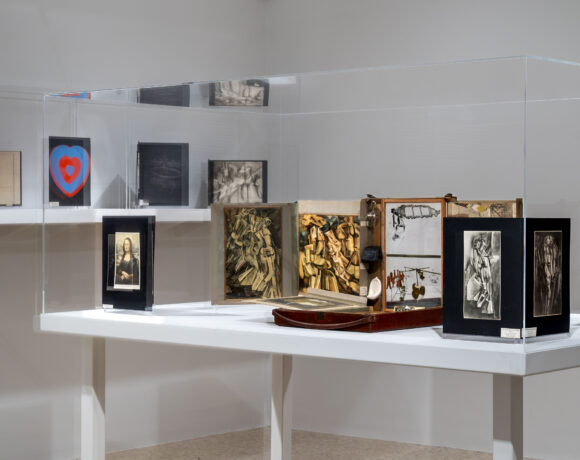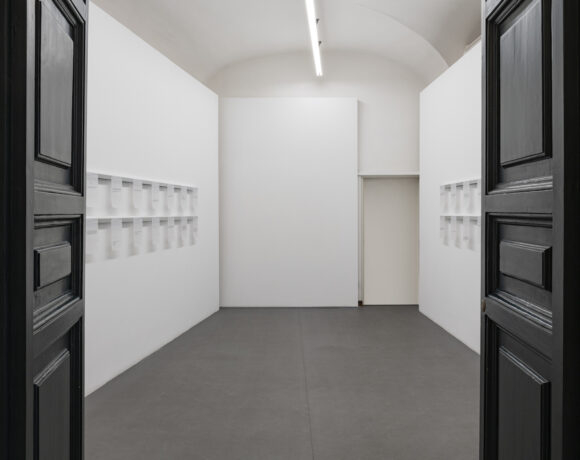In the common language, the verb “to cure” has a protective and reassuring connotation. However, the act of healing may not only refer to conservation and repair, but also to accepting personal wounds and discomforts – physical or emotional – inflicted by events external to our will. Therefore, the healing process often becomes a search for meaning. Elisa Pinto, Mexican, born in 1985 and currently studying at HISK, makes the healing process in its research meaning the vocation of her artistic creation. Starting from a personal experience, she opens up to a major universal meaning, poised between a strong aesthetic effect, and a more restless and submerged – at times disturbing – core. Elisa’s geometric and colorful deconstructions have been displayed in Italy for the first time last September, during the collective exhibition “Forced to Abandon” at the A01 Gallery in Pomigliano d’Arco.
Sara Maietta: I would like to begin our talk with the concept of Chromatic Affirmations, which is the title of one of your works. I think that this is what you generally do: to affirm your vision of the reality through the chromatic spectrum and the beauty of bright colors. Am I right?
Elisa Pinto: Yes, I am interested in the link between colors and emotions. Each color has a different vibration that resonates on us. For Chromatic affirmations, I made an appropriation of images from old medicine books. Each image is laser cut. In this way, the intention was to perform a “surgery” to remove the disease as an act of personal healing. The title of each piece is an “affirmation”, which is a type of healing and each one works specifically for each disease/image. I took these affirmations from the book “Heal your Life” by Louise L. Hay.
So, if you have to describe your research in three words, what would they be – and why?
Healing, because it is related to my father. He passed away a long time ago, he died of cancer. Making Mirror Diagnostic project helped me to deal with his absence and my fear to get sick. Then, memories: some recent works focus on materializing lost childhood memories, in search of a sense of wholeness and belonging. I am also interested in how we relate with the space, in a psychological and emotional way. Finally, construction: I have noticed that my work is like a collage of different media and materials, each work is like a fragment of a whole. I like to use construction materials; I think I have been building myself fragments of a house. I like this idea that we are constantly building ourselves.
You often talk about memory: what is it for you? Is it something that we can heal or is it something that can cause problems and psychological/physical diseases?
I am interested with memories because I have read about the psychologist Julia Shaw, who was trying to implant false memories. And her method is very simple, she asks the patients to imagine something that happened, even if it never happened, she convinces them adding true fragments of the event. By repeating this exercise of imagination, after two weeks the patient starts doubting about if this was something that happened for real or if it is something he/she imagined. With the same idea of repetition, I started making sculptures and graphic work. For me, trying to create those missing memories of my childhood, with my father, was an attempt to build myself a mental refuge, a fortress.
Talking about this: one of the most interesting aspects of your works is the contrast between what we see
– colors, geometry, design, and “happy” aesthetics – and the theme that you analyze, the topics from which the works come. Why? Is it a way to “embellish” the trauma, or is it a way to confuse the spectator?
I have never paid attention to design. I mean, I like design but it has never been my intention to use it in a conscious way. I guess it has been very natural to end up doing something with a design aesthetic. I think this colorful, design aesthetic has its conceptual function, for example in the Mirror diagnostic series. It is also a contrast of topics.
We can say that you rewrite your own elements of fragility to become stronger, to make sense of painful situations when you did not find it…
Yes, it is in a way to rewrite elements of fragility to build a mental fortress.
So, your work is above all autobiographical. When we see your works, we have the idea you are talking with us, even if you are addressing issues that we do not know, because they are part of your personal life. How do you think this is possible?
Without realizing it, my work has come from the inside out. In this way, I have talked about personal memories, but also a lot about emotions. Despite the work is sometimes very abstract, I think the materials have a hidden language that speak to the viewer, perhaps in an unconscious way. I think I give clues in my work which people can connect with and create their own meaning or memory.
So, is art a form of healing? And can it be personal and universal at the same time?
I think it can be a form of healing. For me it has been personal, but for example, in the instruction manual Emotional Sculpture, I tried to make it more open and universal.
When you are not analysing your biography, what are the subjects that you prefer to deconstruct and represent through your artistic experimentations?
I am constantly seeking for spiritual truths and I like to discover how materials, or the combination of materials, can give different sensations and meanings. It is a constant search.
The Covid situation impacted everyone’s life and changed our lives in such a drastic way that many people have to fight with new psychological diseases. Many artists and many people from the art world tried (and are trying) to expiate the difficulties of these times through the artistic practice. Has the Covid pandemic been a personal discomfort for you too? Have you worked through this trauma too? What do you think about this?
Fortunately, for me it has not been a big problem, my family and I are healthy. It has been difficult to travel, though. During the first lockdown in Belgium, I was feeling a little frustrated because I could not continue working in my studio. So, I made the instruction manual Emotional Sculpture, where I gave a more playful answer on what to do with some emotions I was dealing or interested with.
Still reasoning about the pandemic: do you think that the artistic practice can be a way to heal these tough times? Can a universal cure exist?
I think it can be a way to heal or deal with these times, but also can be through meditation or exercise. I think the Earth needs to heal. And maybe the pandemic is part of the process, I hope it makes us understand and wake up so we can be more conscious.
Can you give us any suggestions about your future or imminent projects? What kind of elements are you going to “heal”?
I am now thinking more about installations, kind of tv set aesthetic, related to a house. Actions to inhabit a space, which could work to heal a specific place. I will continue painting, also.
Sara Maietta
Info:
 The artist Elisa Pinto
The artist Elisa Pinto
 Elisa Pinto, Chromatic Affirmations series. I choose to see all people and things with love and joy. Silkscreen on acrylic, acrylics of different colors and acrylic mirror cut with laser, 56 x 80 x 3cm. 2017. Photo by Juan Pablo de la Vega
Elisa Pinto, Chromatic Affirmations series. I choose to see all people and things with love and joy. Silkscreen on acrylic, acrylics of different colors and acrylic mirror cut with laser, 56 x 80 x 3cm. 2017. Photo by Juan Pablo de la Vega
 Elisa Pinto, Chromatic Affirmations series. The movies in my mind are beautiful because I choose to do them that way. I love myself. Screen printing on acrylic and acrylics of different colors cut with laser, 75 x 60 x 3 cm, 2016
Elisa Pinto, Chromatic Affirmations series. The movies in my mind are beautiful because I choose to do them that way. I love myself. Screen printing on acrylic and acrylics of different colors cut with laser, 75 x 60 x 3 cm, 2016
 Elisa Pinto, känslomässig skulptur (Emotional sculpture), black & white printed manual, 21.5 x 28 cm, 2020
Elisa Pinto, känslomässig skulptur (Emotional sculpture), black & white printed manual, 21.5 x 28 cm, 2020
 Elisa Pinto, Bedroom, copper pipes, acrilyc paint on pvc curtains, ceramic figure, briefcase and pillows, 210 cm x 577 cm x 538 cm, 2020. Installation at Netwerk Aalst, Belgium (Photos by Tom Callemin)
Elisa Pinto, Bedroom, copper pipes, acrilyc paint on pvc curtains, ceramic figure, briefcase and pillows, 210 cm x 577 cm x 538 cm, 2020. Installation at Netwerk Aalst, Belgium (Photos by Tom Callemin)

Naples, 1996. She deals with artistic curatorship, with particular attention to emerging artists dealing with political and social criticism. She first graduated in Territoire et Patrimoine at the Université Paris Nanterre, she specialized in Cultural Heritage Management at the Federico II University in Naples with an analytical thesis on the rise and decline of the contemporary art curator. In 2021 she takes part in the N.I.C.E. by Paratissima. She firmly believes in the social value of art, she has collaborated with several Neapolitan galleries and participated in an artistic residency at the Morra Foundation. Meanwhile, she writes for art magazines.






NO COMMENT